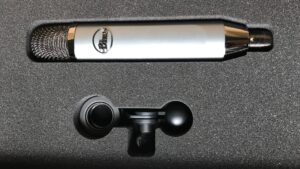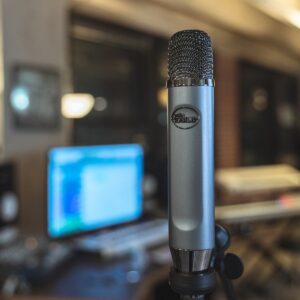In recent years, streaming, YouTubing, and podcasting have become increasingly popular. As a result, user-friendly USB microphones have become wid
In recent years, streaming, YouTubing, and podcasting have become increasingly popular. As a result, user-friendly USB microphones have become widely available. But what if you want the convenience of a USB mic and the sound quality of a professional-grade XLR microphone? The Blue Ember XLR condenser microphone has been designed to filter out ambient noise and deliver high-quality vocal recordings.
How does it stack up compared to the ease of use of a USB microphone? Is it worth investing in this mic for your next project?
What Is Blue Ember
Blue has been renowned for offering USB plug & play solutions with their Yeti and Snowball models. However, many may not be aware that they also have a range of professional XLR products, which are typically expensive and require extra equipment. To address this, Blue has introduced the Blue Ember XLR, intending to provide an affordable option for YouTubers and podcasters to access studio-quality XLR mics. The product was first revealed at CES 2019 in January.

The Ember is unlike typical USB microphones, which use an XLR connection rather than the plug-and-play feature. This means an external device, such as a mixer, preamp, or interface, is necessary to connect the Ember to a computer. While the Ember is an entry-level, cardioid condenser microphone, it is still relatively affordable at under $100, making it a great choice for aspiring content creators.
|
| Microphone & Headphone Amplifier
Transducer Type: Condenser capsule Polar Pattern: Cardioid Connectivity: XLR Frequency Response: 38 Hz-20 kHz Sensitivity: 12 mV/PA Output Impedance: 40 ohms Rate Load Impedance: 1k ohm Maximum SPL: 132 dB SPL Power Requirements: +48V DC Phantom Power Sound Field: Mono Operating Principle: Pressure Gradient
|
| Physical
Weight: 0.38 kg (0.84 lbs.) Dimensions: 219 mm (L), 38.26 mm (W), 31.91 mm (D) Power Source: 48V phantom power Diaphragm Size: Small Diaphragm Included Accessories: Mic Stand Mount Manufacturer Part Number: 988-000379 |
 Main Features Of Blue Ember
Main Features Of Blue Ember
- Suits music and voiceover work to podcasts and video
- Hand-tuned condenser capsule delivers open, detailed sound
- Premium, high-output electronics for maximum clarity and headroom
- Cardioid polar pattern with excellent off-axis noise rejection
- Compact side-address design fits anywhere and looks great on camera
- Works great with home studio audio interfaces
- Low-profile design
- High (146dB) SPL handling — takes drums and guitar amps like a champ
- Requires +48-volt phantom power
- Includes swivel mic stand mount
Design & Build
The Blue Ember has a straightforward aesthetic, with a slender, pencil-like shape that won’t be too intrusive when visible on your stream. There are no buttons or headphone jacks, maintaining its classic look. Compared to the Yeti, which is shorter but more than double the diameter, it will only take up a little space on your face cam. Weighing in at just 380g, it’s lighter than the Yeti’s 550g and the HyperX QuadCast’s 254g.

The Ember’s solid metal construction and smaller diameter give it a robust, reassuring feel for its price point. And its desaturated blue and ash-gray color scheme gives it an attractive look that matches its grille.
The sturdy grill surrounding the mic capsule does not flex when pressure is applied. Moreover, it has a condenser capsule beneath its grille, which captures audio in a cardioid pattern for tracking vocals or instruments while rejecting sound from the opposite direction.
Sound Quality
 The Blue Ember microphone is an excellent value for its price. Its has a remarkably balanced frequency response, with a gradual decrease in volume after 20kHz. Additionally, the 38Hz filter prevents low end interference from outside sources such as air conditioners or traffic noise.
The Blue Ember microphone is an excellent value for its price. Its has a remarkably balanced frequency response, with a gradual decrease in volume after 20kHz. Additionally, the 38Hz filter prevents low end interference from outside sources such as air conditioners or traffic noise.
The internal damping achieves great results in creating a cardioid pattern, rejecting sound from the back side and providing a focused sound from the front. Even without an actual pop filter, you’ll find that recordings sound great when the microphone is place four to seven inches away, making it possible to get intimate-sounding vocals
It’s great for content creators as it is completely free from hiss and other electrical noise. Moreover, the proximity effect is impressive, giving a natural bass boost when speaking close to the mic while still highlighting the mid-tones of the user’s voice. Thus making Blue Ember a suitable mic for podcast recordings.
Ease Of Use
When speaking into the microphone, make sure the front of the grill is pointing towards you. To ensure you get the best sound quality, keep the Blue logo facing you and the microphone parallel to your face. This will help minimize any background noise.
Drawbacks Of Blue Ember
 This microphone does not come with a pop filter, so it is strongly suggested that you buy one; even though it looks like the basket contains foam, it does not protect against plosives.
This microphone does not come with a pop filter, so it is strongly suggested that you buy one; even though it looks like the basket contains foam, it does not protect against plosives.
The Ember microphone is a great product for its price. However, it’s important to note that the total cost of getting started with this mic may be higher than the initial $99. An arm, cable, and interface will likely add $50 or more to the cost, and if you want to add a shock mount and pop filter, that will be another $30.
Another drawback of the mic is the need for a recording interface with +48V phantom power to support the Blue Ember’s power requirements. Again, this can add cost to the recording setup and limit Ember’s portability.
Final Verdict
The Blue Ember microphone is a great option for anyone looking for a budget-friendly entry-level XLR condenser microphone that can deliver clean, crisp vocals. Its slim design and muted appearance make it a great addition to any recording setup without being an eyesore. With the right accessories, the Blue Ember can offer great bang for your buck and provide excellent sound quality.
| Excellent sound isolation from off-axis sources | Requires external interface with +48V phantom power. |
| Extremely versatile | No accessories included. |
| Easily transportable with XLR mic compatibility | More complex than a USB microphone. |
| Clear and articulate audio | High cost to acquire all necessary hardware |
| Outstanding capability to reduce plosive-produced pops | |
| Highly affordable |
The Blue Ember is an excellent choice for home studios and streamers seeking a non-USB condenser mic. Its unassuming look makes it an excellent value for capturing professional-sounding audio without breaking the bank.


COMMENTS